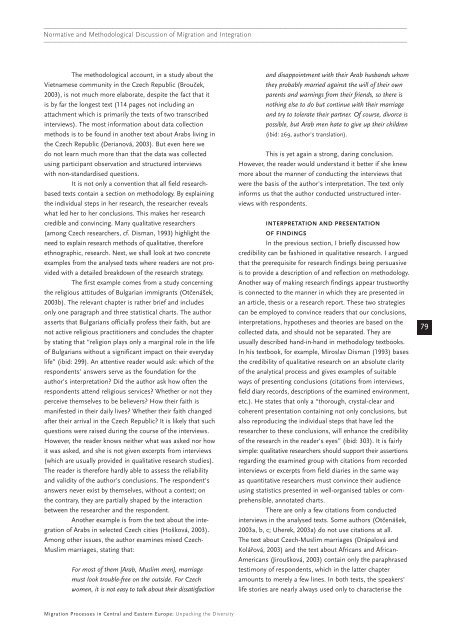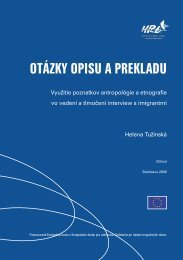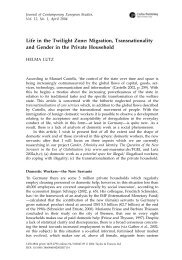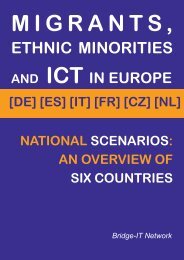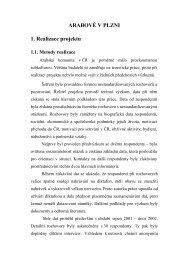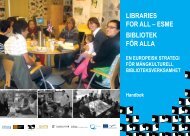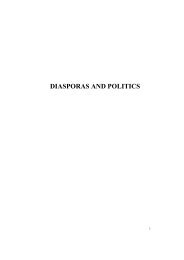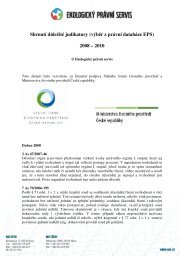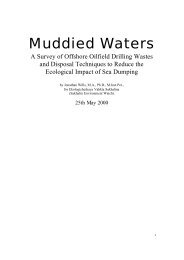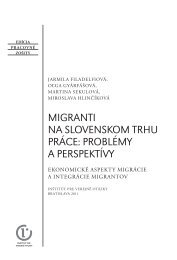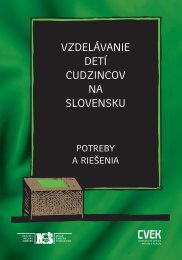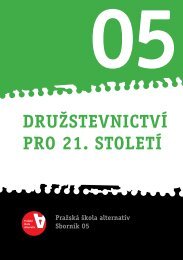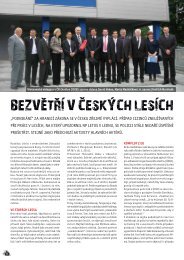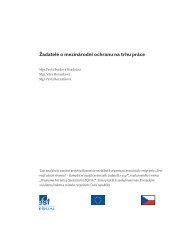Migration Processes in Central and Eastern Europe - Multiple Choices
Migration Processes in Central and Eastern Europe - Multiple Choices
Migration Processes in Central and Eastern Europe - Multiple Choices
You also want an ePaper? Increase the reach of your titles
YUMPU automatically turns print PDFs into web optimized ePapers that Google loves.
———————————————————————————————————————————————————————————————<br />
Normative <strong>and</strong> Methodological Discussion of <strong>Migration</strong> <strong>and</strong> Integration<br />
———————————————————————————————————————————————————————————————<br />
The methodological account, <strong>in</strong> a study about the<br />
Vietnamese community <strong>in</strong> the Czech Republic (Brouček,<br />
2003), is not much more elaborate, despite the fact that it<br />
is by far the longest text (114 pages not <strong>in</strong>clud<strong>in</strong>g an<br />
attachment which is primarily the texts of two transcribed<br />
<strong>in</strong>terviews). The most <strong>in</strong>formation about data collection<br />
methods is to be found <strong>in</strong> another text about Arabs liv<strong>in</strong>g <strong>in</strong><br />
the Czech Republic (Derianová, 2003). But even here we<br />
do not learn much more than that the data was collected<br />
us<strong>in</strong>g participant observation <strong>and</strong> structured <strong>in</strong>terviews<br />
with non-st<strong>and</strong>ardised questions.<br />
It is not only a convention that all field researchbased<br />
texts conta<strong>in</strong> a section on methodology. By expla<strong>in</strong><strong>in</strong>g<br />
the <strong>in</strong>dividual steps <strong>in</strong> her research, the researcher reveals<br />
what led her to her conclusions. This makes her research<br />
credible <strong>and</strong> conv<strong>in</strong>c<strong>in</strong>g. Many qualitative researchers<br />
(among Czech researchers, cf. Disman, 1993) highlight the<br />
need to expla<strong>in</strong> research methods of qualitative, therefore<br />
ethnographic, research. Next, we shall look at two concrete<br />
examples from the analysed texts where readers are not provided<br />
with a detailed breakdown of the research strategy.<br />
The first example comes from a study concern<strong>in</strong>g<br />
the religious attitudes of Bulgarian immigrants (Otčenášek,<br />
2003b). The relevant chapter is rather brief <strong>and</strong> <strong>in</strong>cludes<br />
only one paragraph <strong>and</strong> three statistical charts. The author<br />
asserts that Bulgarians officially profess their faith, but are<br />
not active religious practitioners <strong>and</strong> concludes the chapter<br />
by stat<strong>in</strong>g that “religion plays only a marg<strong>in</strong>al role <strong>in</strong> the life<br />
of Bulgarians without a significant impact on their everyday<br />
life” (ibid: 299). An attentive reader would ask: which of the<br />
respondents' answers serve as the foundation for the<br />
author's <strong>in</strong>terpretation? Did the author ask how often the<br />
respondents attend religious services? Whether or not they<br />
perceive themselves to be believers? How their faith is<br />
manifested <strong>in</strong> their daily lives? Whether their faith changed<br />
after their arrival <strong>in</strong> the Czech Republic? It is likely that such<br />
questions were raised dur<strong>in</strong>g the course of the <strong>in</strong>terviews.<br />
However, the reader knows neither what was asked nor how<br />
it was asked, <strong>and</strong> she is not given excerpts from <strong>in</strong>terviews<br />
(which are usually provided <strong>in</strong> qualitative research studies).<br />
The reader is therefore hardly able to assess the reliability<br />
<strong>and</strong> validity of the author's conclusions. The respondent's<br />
answers never exist by themselves, without a context; on<br />
the contrary, they are partially shaped by the <strong>in</strong>teraction<br />
between the researcher <strong>and</strong> the respondent.<br />
Another example is from the text about the <strong>in</strong>tegration<br />
of Arabs <strong>in</strong> selected Czech cities (Hošková, 2003).<br />
Among other issues, the author exam<strong>in</strong>es mixed Czech-<br />
Muslim marriages, stat<strong>in</strong>g that:<br />
For most of them [Arab, Muslim men], marriage<br />
must look trouble-free on the outside. For Czech<br />
women, it is not easy to talk about their dissatisfaction<br />
<strong>and</strong> disappo<strong>in</strong>tment with their Arab husb<strong>and</strong>s whom<br />
they probably married aga<strong>in</strong>st the will of their own<br />
parents <strong>and</strong> warn<strong>in</strong>gs from their friends, so there is<br />
noth<strong>in</strong>g else to do but cont<strong>in</strong>ue with their marriage<br />
<strong>and</strong> try to tolerate their partner. Of course, divorce is<br />
possible, but Arab men hate to give up their children<br />
(ibid: 269, author's translation).<br />
This is yet aga<strong>in</strong> a strong, dar<strong>in</strong>g conclusion.<br />
However, the reader would underst<strong>and</strong> it better if she knew<br />
more about the manner of conduct<strong>in</strong>g the <strong>in</strong>terviews that<br />
were the basis of the author's <strong>in</strong>terpretation. The text only<br />
<strong>in</strong>forms us that the author conducted unstructured <strong>in</strong>terviews<br />
with respondents.<br />
INTERPRETATION AND PRESENTATION<br />
OF FINDINGS<br />
In the previous section, I briefly discussed how<br />
credibility can be fashioned <strong>in</strong> qualitative research. I argued<br />
that the prerequisite for research f<strong>in</strong>d<strong>in</strong>gs be<strong>in</strong>g persuasive<br />
is to provide a description of <strong>and</strong> reflection on methodology.<br />
Another way of mak<strong>in</strong>g research f<strong>in</strong>d<strong>in</strong>gs appear trustworthy<br />
is connected to the manner <strong>in</strong> which they are presented <strong>in</strong><br />
an article, thesis or a research report. These two strategies<br />
can be employed to conv<strong>in</strong>ce readers that our conclusions,<br />
<strong>in</strong>terpretations, hypotheses <strong>and</strong> theories are based on the<br />
collected data, <strong>and</strong> should not be separated. They are<br />
usually described h<strong>and</strong>-<strong>in</strong>-h<strong>and</strong> <strong>in</strong> methodology textbooks.<br />
In his textbook, for example, Miroslav Disman (1993) bases<br />
the credibility of qualitative research on an absolute clarity<br />
of the analytical process <strong>and</strong> gives examples of suitable<br />
ways of present<strong>in</strong>g conclusions (citations from <strong>in</strong>terviews,<br />
field diary records, descriptions of the exam<strong>in</strong>ed environment,<br />
etc.). He states that only a “thorough, crystal-clear <strong>and</strong><br />
coherent presentation conta<strong>in</strong><strong>in</strong>g not only conclusions, but<br />
also reproduc<strong>in</strong>g the <strong>in</strong>dividual steps that have led the<br />
researcher to these conclusions, will enhance the credibility<br />
of the research <strong>in</strong> the reader's eyes” (ibid: 303). It is fairly<br />
simple: qualitative researchers should support their assertions<br />
regard<strong>in</strong>g the exam<strong>in</strong>ed group with citations from recorded<br />
<strong>in</strong>terviews or excerpts from field diaries <strong>in</strong> the same way<br />
as quantitative researchers must conv<strong>in</strong>ce their audience<br />
us<strong>in</strong>g statistics presented <strong>in</strong> well-organised tables or comprehensible,<br />
annotated charts.<br />
There are only a few citations from conducted<br />
<strong>in</strong>terviews <strong>in</strong> the analysed texts. Some authors (Otčenášek,<br />
2003a, b, c; Uherek, 2003a) do not use citations at all.<br />
The text about Czech-Muslim marriages (Drápalová <strong>and</strong><br />
Kolářová, 2003) <strong>and</strong> the text about Africans <strong>and</strong> African-<br />
Americans (Jiroušková, 2003) conta<strong>in</strong> only the paraphrased<br />
testimony of respondents, which <strong>in</strong> the latter chapter<br />
amounts to merely a few l<strong>in</strong>es. In both texts, the speakers'<br />
life stories are nearly always used only to characterise the<br />
79<br />
<strong>Migration</strong> <strong>Processes</strong> <strong>in</strong> <strong>Central</strong> <strong>and</strong> <strong>Eastern</strong> <strong>Europe</strong>: Unpack<strong>in</strong>g the Diversity


